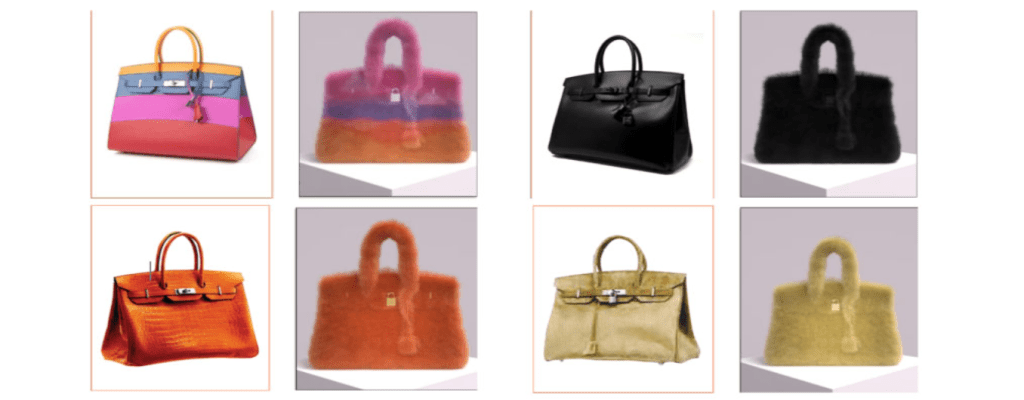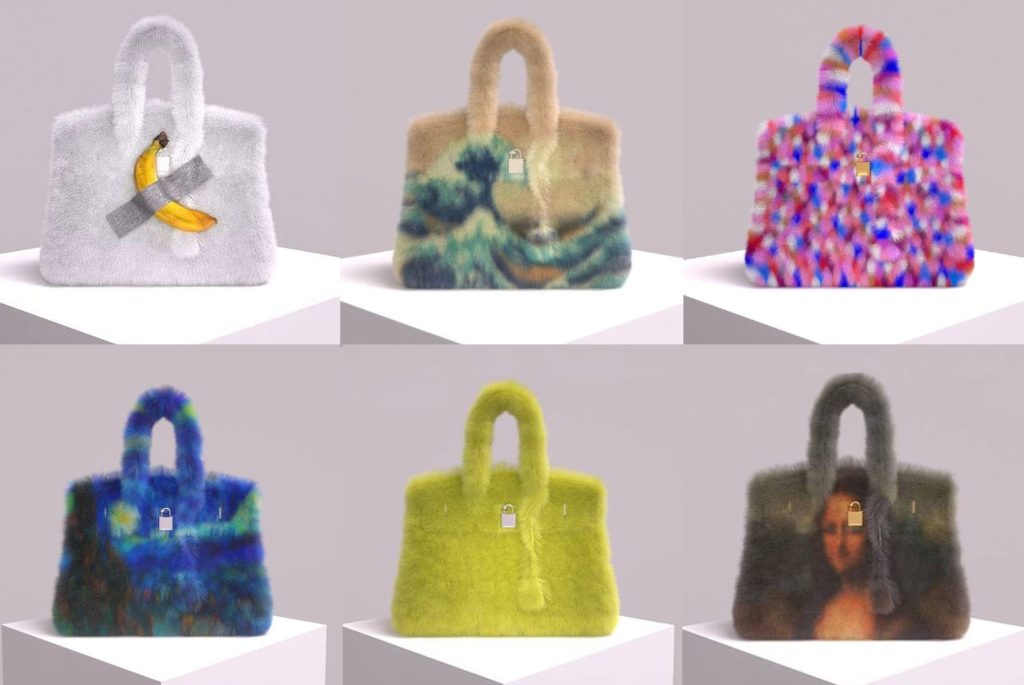The February 8 jury verdict in favor of Hermès in the MetaBirkins case “rests on a solid foundation of substantial evidence,” the Birkin bag-maker asserts in the opposition that it lodged with the U.S. District Court for the Southern District of New York this week. Pushing back against Mason Rothschild’s renewed JMOL/new trial motion, counsel for Hermès argues that Rothschild puts forth “an amalgam of new (and thus waived) arguments, unsubstantiated speculation, and meritless allegations,” and even if his arguments were appropriate, they are “unavailing,” as Hermès “presented sufficient evidence to support the verdict that Rothschild was liable for trademark infringement, trademark dilution, and cybersquatting.”
At a high-level, Hermès asserts that: (1) Rothschild’s arguments concerning instruction no. 14 – namely, the inclusion of language concerning Rothschild’s intent – were waived and are, nonetheless, insufficient; (2) sufficient evidence supports the verdict on all of Hermès’s claims, as: (i) there was sufficient evidence establishing that Rothschild infringed on the BIRKIN mark; (ii) Rothschild diluted the BIRKIN mark; and (iii) there was sufficient evidence establishing that Rothschild committed cybersquatting; (3) Hermès presented sufficient evidence to support the jury’s finding that the First Amendment did not bar any of its claims; (4) Dr. Gopnik was properly excluded, and the questioning of Dr. Neal was not prejudicial; and (5) Rothschild’s baseless claim that the Lanham Act does not apply to digital goods should be rejected for the reasons the court previously rejected it.
Trademark Infringement Claim – Hermès asserts that it produced evidence showing that each of the Polaroid factors (for determining likelihood of confusion) weigh heavily in its favor. A quick rundown of Hermès claim is as follows …
Strength of the BIRKIN mark – There was “no dispute that the BIRKIN mark is strong,” as Hermès “owns significant trademark rights in its BIRKIN handbags, including U.S. trademark registrations covering the BIRKIN mark and the trade dress of the BIRKIN handbag.”
Similarity of the marks – The marks are similar (“BIRKIN” vs. “METABIRKINS”) and it is “clear” that “Rothschild copied [the] commercial implementation of the BIRKIN handbags” and Hermès’ federally registered trade dress for the METABIRKINS NFTs.

Evidence of actual confusion – Rothschild “admitted to actual confusion,” including by claiming that he and his publicist “corrected … instances of confusion.” Beyond that, “Comments on Rothschild’s social media showed that potential purchasers were confused.” And Hermès points to a consumer survey completed by its expert Dr. Bruce Isaacson, who found that “the net confusion among NFT purchasers was 18.7%, [and that] based on this finding, he concluded there was a substantial likelihood of confusion.”
Likelihood of bridging the gap – Hermès had “concrete and realistic plans to produce and sell its own NFTs using the BIRKIN mark since at least 2019,” and showed the jury “some of these projects, including an NFT of a horse that was provided at an employee-only event.”
Competitive proximity of the products – The METABIRKINS NFTs and Hermès’ products “compete for the same consumers,” particularly since “Rothschild intended the METABIRKINS NFTs to be a ‘[l]uxury product’ and sought to bring the luxury BIRKIN handbags into the metaverse.”
Bad faith – There was “ample evidence of Rothschild’s bad faith adoption of the BIRKIN mark,” stemming from the fact that he “saw a financial opportunity when major fashion brands entered the metaverse and sold branded digital products for significant prices,” and “deceived investors and business associates that he was either partnering with or otherwise had approval from Hermès.”
Consumer sophistication – “The evidence at trial showed NFTs consumers are not particularly sophisticated – the NFT marketplace is immature and highly speculative.”
Trademark Dilution Claim – Hermès similarly asserts that it there is sufficient evidence that Rothschild diluted its famous BIRKIN trademark, including Rothschild’s own acknowledgment of “the blurring effect of his NFTs.”
In pushing for a judgment or new trial, Hermès notes that Rothschild advances a new theory, in which he claims that “he is not liable for dilution because his speech was not commercial.” Part of the problem, according to Hermès is that Rothschild “waived this argument by waiting to raise it now.” And even still, that argument fails, as “the evidence presented at trial made clear that Rothschild’s METABIRKINS NFTs were a commercial product that he promoted for the purpose of making a profit.”
First Amendment – Skipping ahead, Hermès states that it presented sufficient evidence to support the jury’s finding that despite Rothchild’s argument to the contrary, the First Amendment does not bar any of its claims because “Rothschild actually intended to confuse potential customers, [and thus], waived any First Amendment protection.” Specifically, Hermès asserts that it successfully showed that: (1) based on Rothschild’s “infringing conduct, private communications, and false statements made under oath, the jury properly found that [he] intentionally misled potential consumers;” (2) he was “engaged in brand building, not artistic commentary;” (3) he intended to confuse potential consumers; and (4) it presented sufficient evidence that “there was a particularly compelling showing of likelihood of confusion.”
Among other things, Hermès claims that at trial, the “jury unequivocally took into consideration Rothschild’s credibility when it concluded that neither he nor his claims of artistic motive were credible.” In addition to showing that Rothschild was “misleading” and that “there was no contemporaneous evidence to support his arguments,” Hermès contends that it proved that the alleged “commentary” behind the MetaBirkins NFTs “was just a pretext and Rothschild was actually engaged in brand building for a commercial product.” According to Hermès, “Rothschild understood that he had ‘a fucking gem on [his] hands’ with these METABIRKINS NFTs,” and aimed to bolster the “brand” and “maximize his profits” by engaging influencers to promote the METABIRKINS NFTs.
Distinguishing the MetaBirkins artwork from the other aspects of the NFT project, Hermès asserts that expert Dr. Kominers “observed that purchasers were not interested in the METABIRKINS NFTs for their visual features,” especially since the NFTs were initially tied to “a shrouded image” and sold before the furry Birkin bag-like images were swapped in. Instead, he found that buyers were interested in “the various forms of utility [that Rothschild promised], ‘and particularly the opportunity to use digital Birkin bags in the metaverse.’”
In terms of Rothschild’s alleged intent to confuse, Hermès claims that from the outset of the project, he “referred to the NFTs merely as ‘Birkins,’” and that he “planned promotional campaigns for the second collection which omitted the generic prefix ‘meta’ and encouraged consumers to refer to the NFTs simply as ‘Birkins.’” Further, he “made numerous statements to investors and associates, deceiving them that he was collaborating with or otherwise had approval from Hermès.”
Finally, Hermès asserts that the jury heard “a particularly compelling case of likelihood of confusion with all relevant Polaroid factors weighing in Hermès’s favor,” and “appropriately concluded that the Rothschild’s adoption and use of the BIRKIN mark was expressly misleading and not protected by First Amendment.”
Dastar – In terms of Rothschild’s argument that the Lanham Act does not apply to digital goods, Hermès claims that he “continues to intentionally misstate Dastar’s holding,” and ignore “decades of the Lanham Act’s application to virtual goods – and even longer application to services.” As the court “explained in previously rejecting this frivolous argument, ‘Dastar said nothing at all about the general applicability of the Lanham Act to intangible goods. Rather, the Supreme Court sought to underscore the subtle distinction between copyright — with its focus on encouraging the production of creative content – and trademark – aimed principally at preventing confusion regarding consumer goods.’”
Moreover, the cases cited by Rothschild on this front – Phoenix Entertainment Partners v. Rumsey and an unpublished order from Pulse Entertainment Corp. v. David – are “inapposite and offer no different explanation,” per Hermès.
For these reasons (and others), Hermès asks the court to deny Rothschild’s motion for judgment as a matter of law or for new trial.
The case is Hermès International, et al. v. Mason Rothschild, 1:22-cv-00384 (SDNY).











